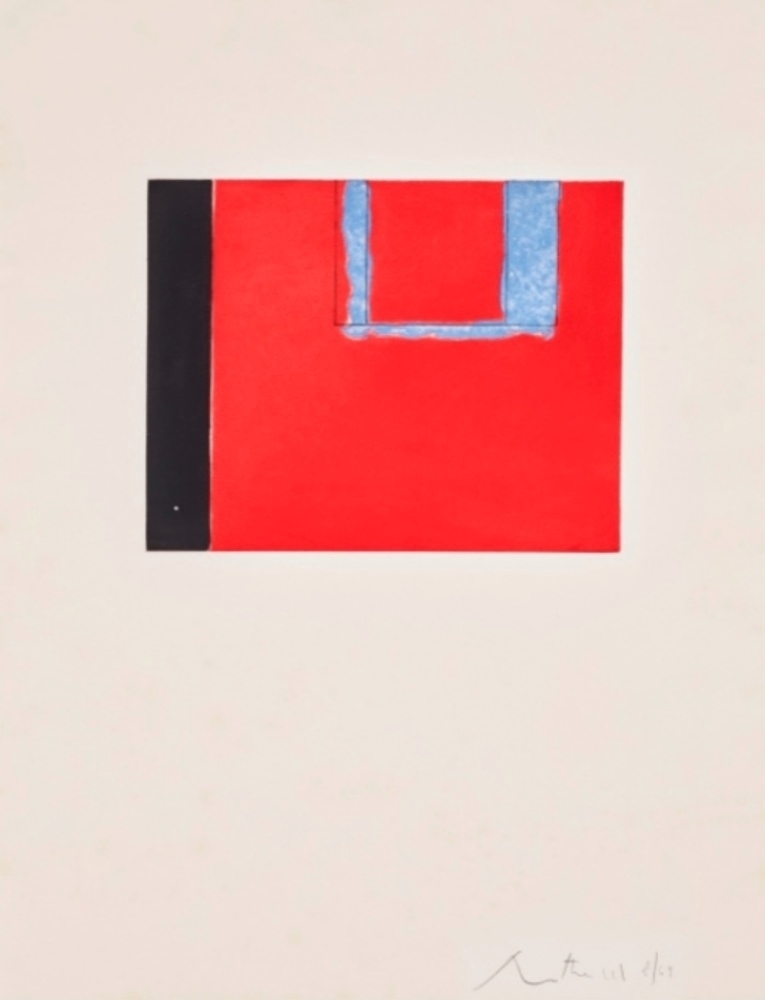Etching and aquatint on BFK Rives paper by Robert Motherwell – Untitled abstract or Red open with blue and black, 1975
Original limited edition fine art print by Robert Motherwell – Untitled abstract or Red open with blue and black, 1975
Etching and aquatint on Rives BFK paper signed and numbered in pencil by the artist on lower right etching bears also the blind stamp of the artist. One of an edition of 69 signed and numbered etchings besides 12 Roman numbered artist proofs.
Publishers: Co-published by artist and Brooke Alexander, Inc., New York
References: Literature: Belknap 150; Engberg & Banach 181.
Dimensions: 65.4 x 49.9 cm. – 25.75 x 19.6 in – Image (plate): 23.5 x 30.2 cm – 9.25 x 11.8 in.
Price: * $ CAD (Canadien dollars) – For more information on artist or artworks contact gallery
Clic here to see more Intaglio printings >>
Robert Motherwell (1915 – 1991)
Robert Motherwell was born January 24, 1915 in Aberdeen, Washington, United States, and died July 16, 1991, in Provincetown, Massachusetts. He is an American painter, printmaker and publisher associated with Abstract Expressionism. He was one of the youngest of the New York School, which also included Philip Guston, Willem de Kooning, Jackson Pollock, and Mark Rothko.
He is an only child and his father, a banker, a time president of the Wells Fargo bank, is of Scottish origin and his mother, Irish. Its surname is of medieval Scottish origin and comes from a village where there was a well-known to travelers and called “the well of the Holy Mother” the “Mother-Well”.
He studied painting for a while in San Francisco at the Art Institute then he entered Stanford University in Palo Alto where he obtained the Bachelor of Arts in Philosophy in 1937. He was also interested in music and wrote a dissertation on relationship of Eugene O’Neill and psychoanalysis.
During the summer of 1935, Robert Motherwell made his “tour of Europe”: France, where he met the surrealists and experimented with automatic writing, Italy, Switzerland, Germany, Belgium and England. After studying philosophy at Harvard University in Cambridge, Massachusetts, he wrote a thesis on the journal of Eugène Delacroix. Often presented as the very type of the American painter, Motherwell was always very attached to European culture.
He returned to Paris in 1938 and translated Paul Signac’s book From Eugène Delacroix to neo-impressionism. In 1939, he exhibited for the first time at the Raymond Duncan gallery, a compatriot.
In 1941, he found in New York the exiled surrealists André Breton, Marcel Duchamp, Max Ernst, André Masson, Matta, Yves Tanguy. He published in the surrealist review VVV directed by Breton, Ernst, Duchamp and the painter David Hare, practiced automatic writing with Jackson Pollock and William Baziotes, played chess with Max Ernst who gave him a sculpture and participated in the exhibition First Papers of Surrealism in 1942.
He learned printmaking with the Swiss painter Kurt Seligmann and traveled to Mexico with Matta. From this period, he confessed in 1964, “to have never been a surrealist painter because he did not accept the meaning that surrealism gave to the image.”
Associated with American Abstract Expressionism, Robert Motherwell’s intellectual approach is characterized by the wide range of his interests: philosophy, symbolist literature, psychoanalysis and oriental art. His painting ranges from the most violent lyricism to an almost austere serenity. Black and white has been Motherwell’s staple for over forty years: “Black represents death and anguish, white represents life and radiance.”
+++
Date:
August 3, 2021
See more artworks and bio of
AA-Graphic arts Intaglio printing